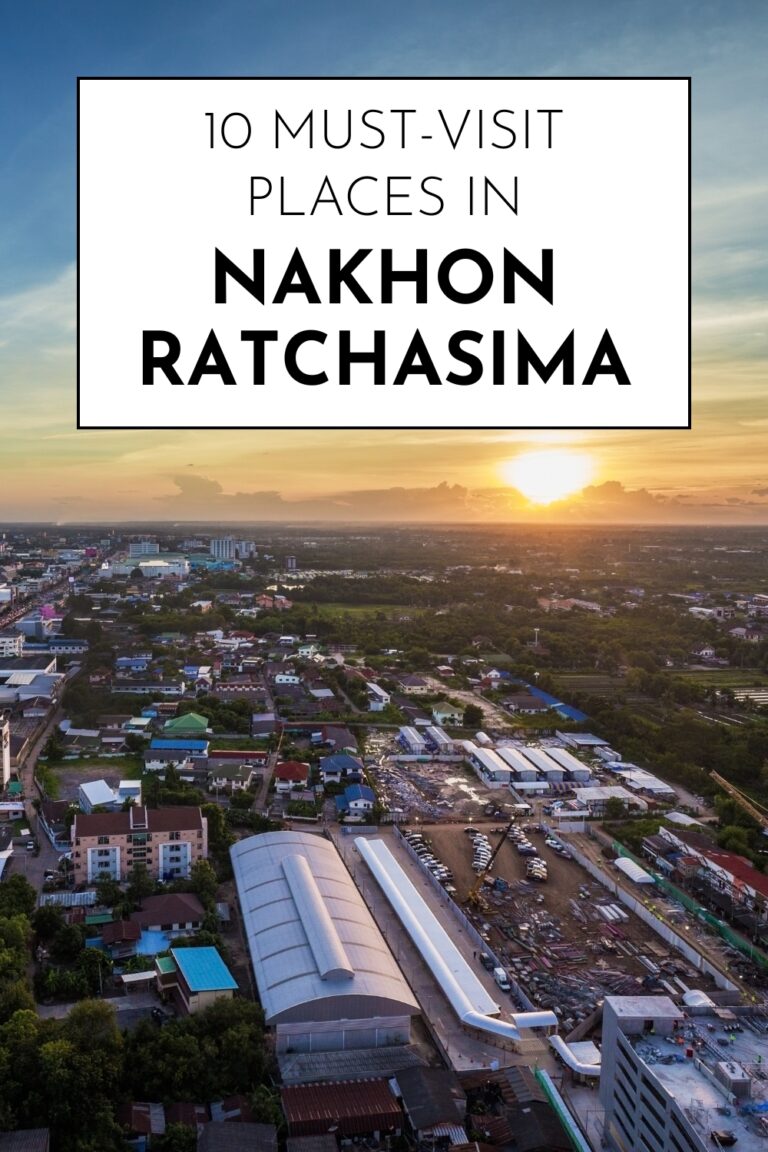Nakhon Ratchasima, affectionately known as “Korat” by locals, stands as Thailand’s largest province and serves as the gateway to the country’s spectacular northeastern region. Located just 260 kilometers from Bangkok, this vibrant destination offers visitors an authentic taste of Isan culture combined with stunning natural landscapes and rich historical heritage.
As the economic and cultural heart of northeastern Thailand, Korat provides a perfect blend of ancient Khmer ruins, pristine national parks, and bustling local markets. The province showcases a different side of Thailand – one where traditional Isan music fills the air, spicy som tam (papaya salad) tantalizes taste buds, and ancient temples tell stories of civilizations past.
From the UNESCO World Heritage Site of Khao Yai National Park to the mysterious Khmer ruins of Phimai, Nakhon Ratchasima offers experiences that range from wildlife encounters to cultural immersion. The region’s unique position at the crossroads of ancient trade routes has created a fascinating mix of influences that continue to shape local traditions today.
Whether you’re an adventure seeker looking to explore Thailand’s oldest national park, a history enthusiast eager to discover ancient Khmer architecture, or a culture lover wanting to experience authentic Isan traditions, Korat delivers unforgettable memories. Let’s explore the ten essential destinations that make this province a must-visit location for travelers seeking authentic Thai experiences beyond the typical tourist trail.
1. Khao Yai National Park – Wildlife Paradise
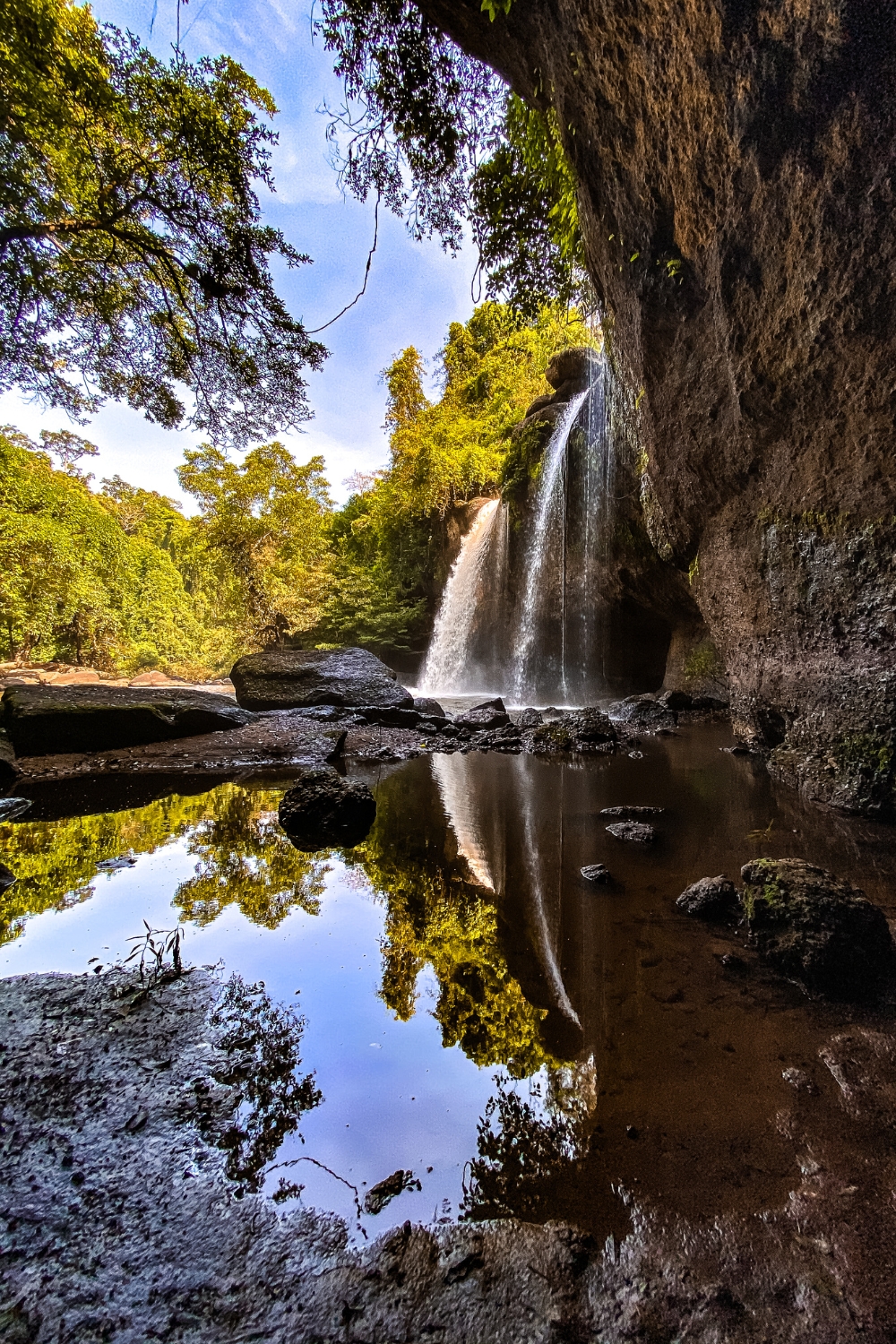
Khao Yai National Park, Thailand’s first national park and a UNESCO World Heritage Site, represents one of Southeast Asia’s most important wildlife conservation areas. Spanning over 2,100 square kilometers of pristine forest, this natural wonderland offers visitors incredible opportunities to encounter wild elephants, exotic birds, and cascading waterfalls.
Diverse Ecosystems and Wildlife Encounters
The park protects diverse ecosystems ranging from dense tropical rainforest to open grasslands, supporting over 3,000 plant species and 320 bird species. Large mammals including Asian elephants, wild boar, deer, and various monkey species roam freely throughout the park’s pristine wilderness.
Night safaris reveal nocturnal creatures like civets, porcupines, and various owl species. Lucky visitors might spot the elusive Asian black bear or clouded leopard, though these magnificent predators remain rare and secretive. The park’s elephant population of approximately 300 individuals provides regular sightings for patient observers.
Haew Narok Waterfall, the park’s most spectacular cascade, plunges 150 meters in three tiers and gained fame as a filming location for “The Beach” movie. The waterfall flows year-round but reaches peak volume during the rainy season from June to October.
Best time to visit: November to February for comfortable weather and active wildlife
Entry fee: 400 THB for adults, 200 THB for children
Accommodation: Park bungalows, camping sites, and nearby resorts available
2. Phimai Historical Park – Ancient Khmer Masterpiece

Phimai Historical Park preserves one of Thailand’s most significant Khmer temple complexes, dating from the 11th to 12th centuries. This remarkable archaeological site showcases the artistic and architectural achievements of the Khmer Empire at its zenith.
Architectural Marvel and Historical Significance
The main temple, Prasat Phimai, represents the pinnacle of Khmer architectural design with its intricate stone carvings, soaring towers, and sophisticated construction techniques. Built primarily from sandstone and laterite, the temple demonstrates the advanced engineering skills of ancient Khmer builders.
The temple complex served as a vital religious center along the ancient highway connecting Angkor to the northern provinces of the Khmer Empire. Detailed relief carvings depict scenes from Hindu epics, Buddhist teachings, and daily life during the Khmer period.
Phimai National Museum, located within the park, houses an impressive collection of Khmer artifacts including sculptures, pottery, and architectural fragments. The museum’s exhibits provide context for understanding the temple’s historical importance and artistic significance.
Historical period: 11th-12th centuries
Architectural style: Bayon period Khmer design
Nearby attractions: Phimai town, Sai Ngam banyan tree grove
3. Pak Chong District – Mountain Retreat and Wine Country
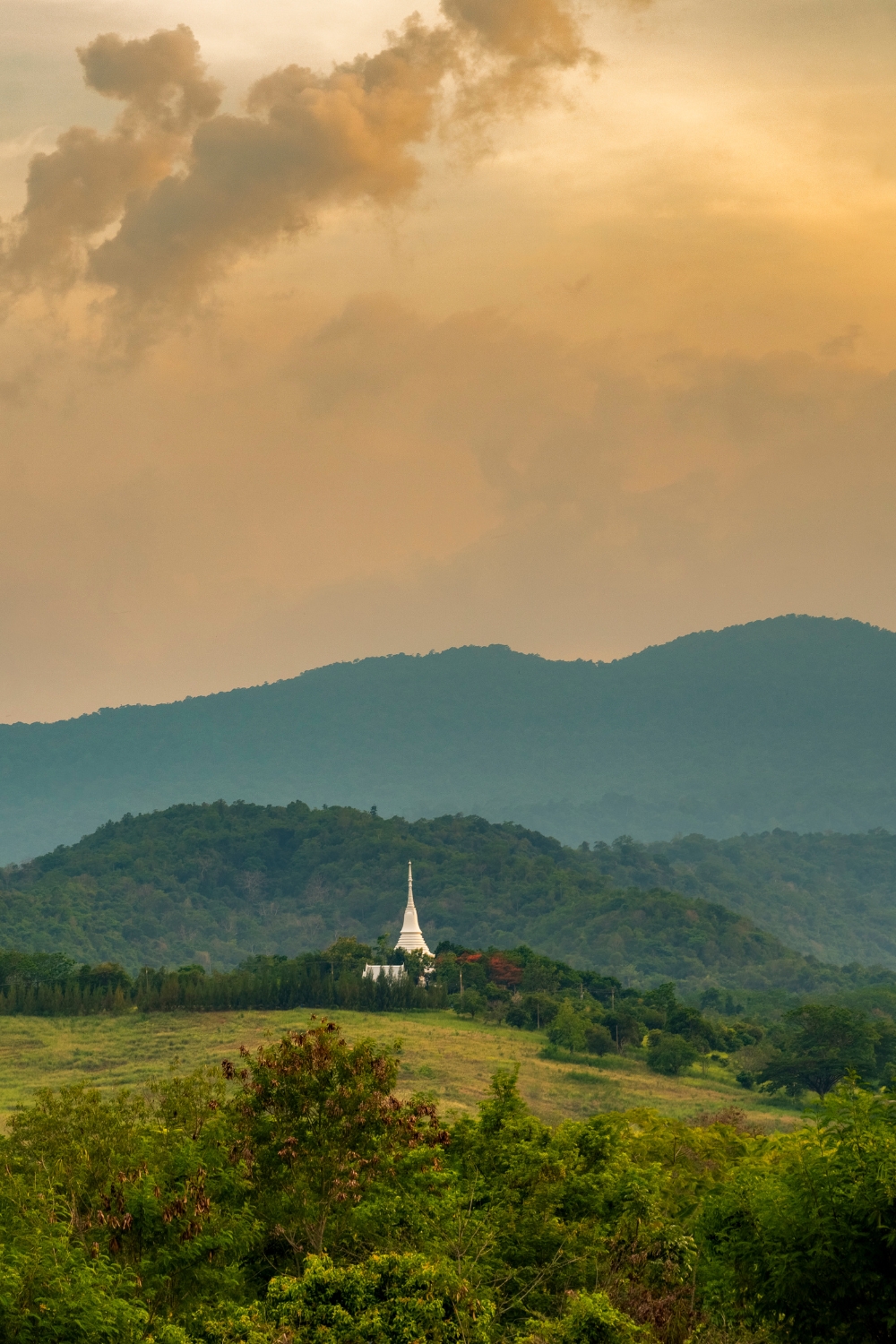
Pak Chong District offers a refreshing mountain escape with cool temperatures, scenic landscapes, and Thailand’s emerging wine industry. This popular weekend destination provides a perfect base for exploring Khao Yai National Park while enjoying resort amenities and local attractions.
Wine Tourism and Scenic Beauty
GranMonte Vineyard, Thailand’s award-winning winery, produces internationally recognized wines using locally grown grapes adapted to tropical conditions. Vineyard tours include wine tastings, cellar visits, and panoramic views of rolling hills covered in grapevines.
PB Valley Khao Yai Winery offers another world-class wine experience with its European-style architecture and comprehensive wine education programs. The winery’s restaurant serves gourmet cuisine paired with their signature wines, creating memorable dining experiences.
The area’s cool climate, created by its elevation of 400-800 meters above sea level, supports diverse agriculture including strawberry farms, flower gardens, and organic vegetable plots. Many farms welcome visitors for picking experiences and fresh produce sales.
Climate: Cool year-round, especially pleasant November-February
Wine season: Harvest typically occurs February-March
Activities: Wine tasting, farm visits, scenic drives
4. Korat Zoo – Conservation and Education
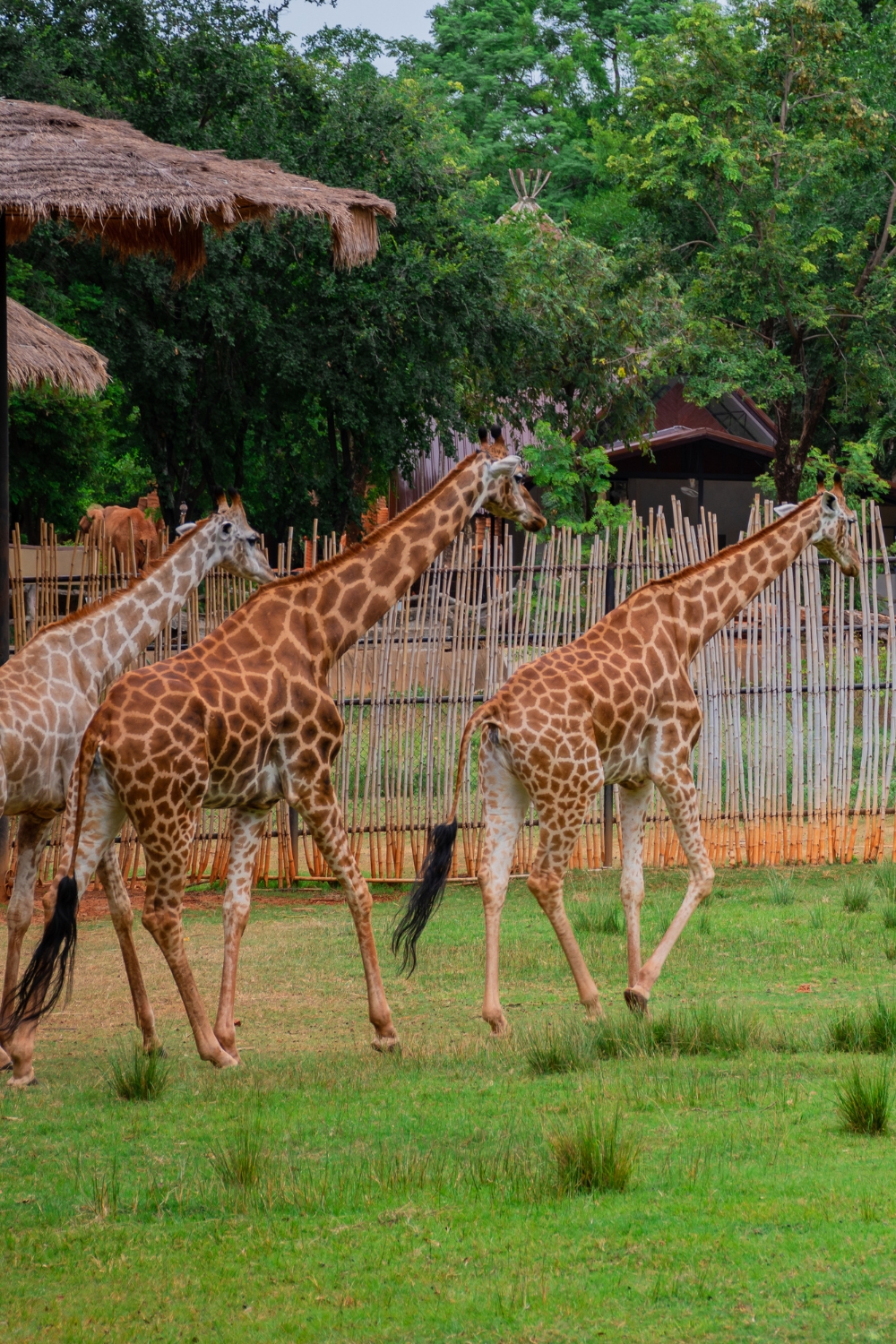
Korat Zoo combines wildlife conservation, education, and family entertainment across 200 hectares of landscaped grounds. This modern zoological facility houses over 1,200 animals representing 200 species from around the world.
Wildlife Conservation and Educational Programs
The zoo’s breeding programs focus on endangered species including white rhinoceros, Malayan tapirs, and various primate species. Successful breeding efforts have contributed to international conservation programs and species reintroduction initiatives.
Educational programs include animal shows, keeper talks, and interactive exhibits that teach visitors about wildlife conservation and environmental protection. The zoo’s veterinary hospital provides medical care for rescued wildlife and supports regional conservation efforts.
Special attractions include the African Safari zone where visitors can observe lions, zebras, and giraffes in spacious naturalistic habitats. The nocturnal animal house allows observation of night-active species during daylight hours.
Operating hours: 8:00 AM – 6:00 PM daily
Special experiences: Animal feeding sessions, behind-the-scenes tours
Facilities: Restaurants, gift shops, playground areas
5. Dan Kwian Pottery Village – Traditional Craftsmanship
Dan Kwian village has maintained traditional pottery-making techniques for over 200 years, creating distinctive ceramic pieces using local clay rich in iron oxide. This cultural heritage site offers visitors opportunities to observe master craftsmen and purchase authentic handmade ceramics.
Traditional Techniques and Unique Clay
The village’s pottery gains its characteristic reddish-brown color from iron-rich clay deposits found only in this region. Local potters shape clay using traditional wheels and fire pieces in wood-burning kilns that have been used for generations.
Visitors can observe the entire pottery-making process from clay preparation to final firing. Many workshops offer hands-on experiences where travelers can try their hand at shaping clay under expert guidance.
The village produces both functional items like water jugs and cooking pots, as well as decorative pieces including sculptures and artistic vessels. Each piece reflects the individual potter’s skill and creativity while maintaining traditional design elements.
Pottery techniques: Traditional wheel throwing, hand building
Unique features: Iron-rich clay creates distinctive red coloration
Shopping: Factory prices, custom orders available
6. Thao Suranaree Monument – Cultural Icon
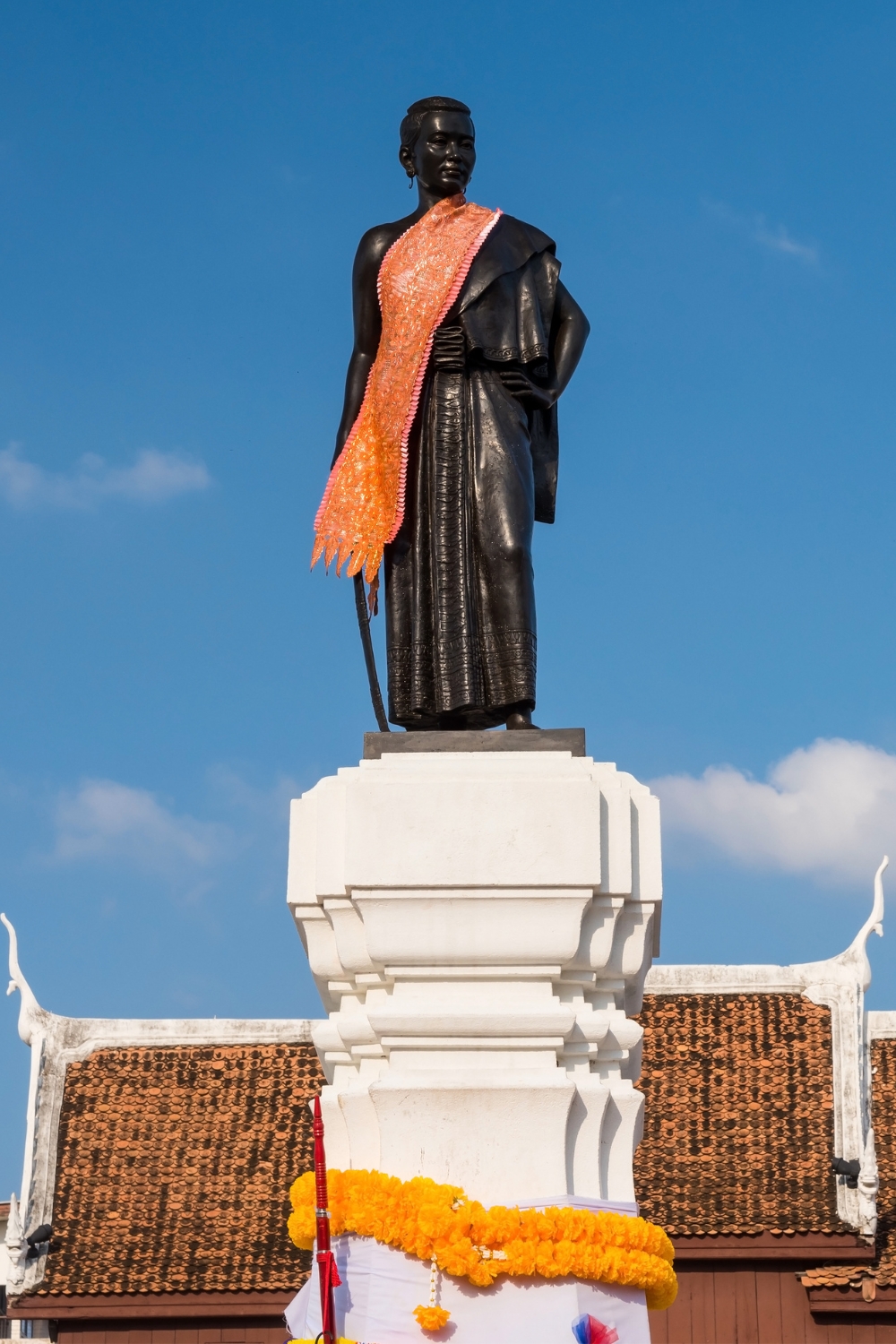
The Thao Suranaree Monument honors Ya Mo, a heroic local woman who defended Korat against Lao invaders in 1826. This important cultural landmark serves as a symbol of local pride and female empowerment in Thai history.
Historical Heroism and Local Traditions
Thao Suranaree, also known as Ya Mo, led the resistance against Lao forces who had captured Korat and were marching captives toward Vientiane. Her clever strategy of encouraging captives to escape during a drunken celebration saved thousands of lives and preserved the city’s independence.
The monument features a bronze statue of Ya Mo in traditional dress, surrounded by landscaped gardens and ceremonial areas. Local people regularly make offerings of flowers, incense, and food to honor her memory and seek her protection.
Annual festivals celebrating Thao Suranaree’s heroism include parades, cultural performances, and traditional ceremonies. These events showcase Isan culture through music, dance, and local cuisine while honoring the region’s historical heritage.
Cultural significance: Symbol of local resistance and female leadership
Festival dates: Late March annually
Location: Central Korat city, easily accessible
7. Wat Sala Loi – Floating Temple
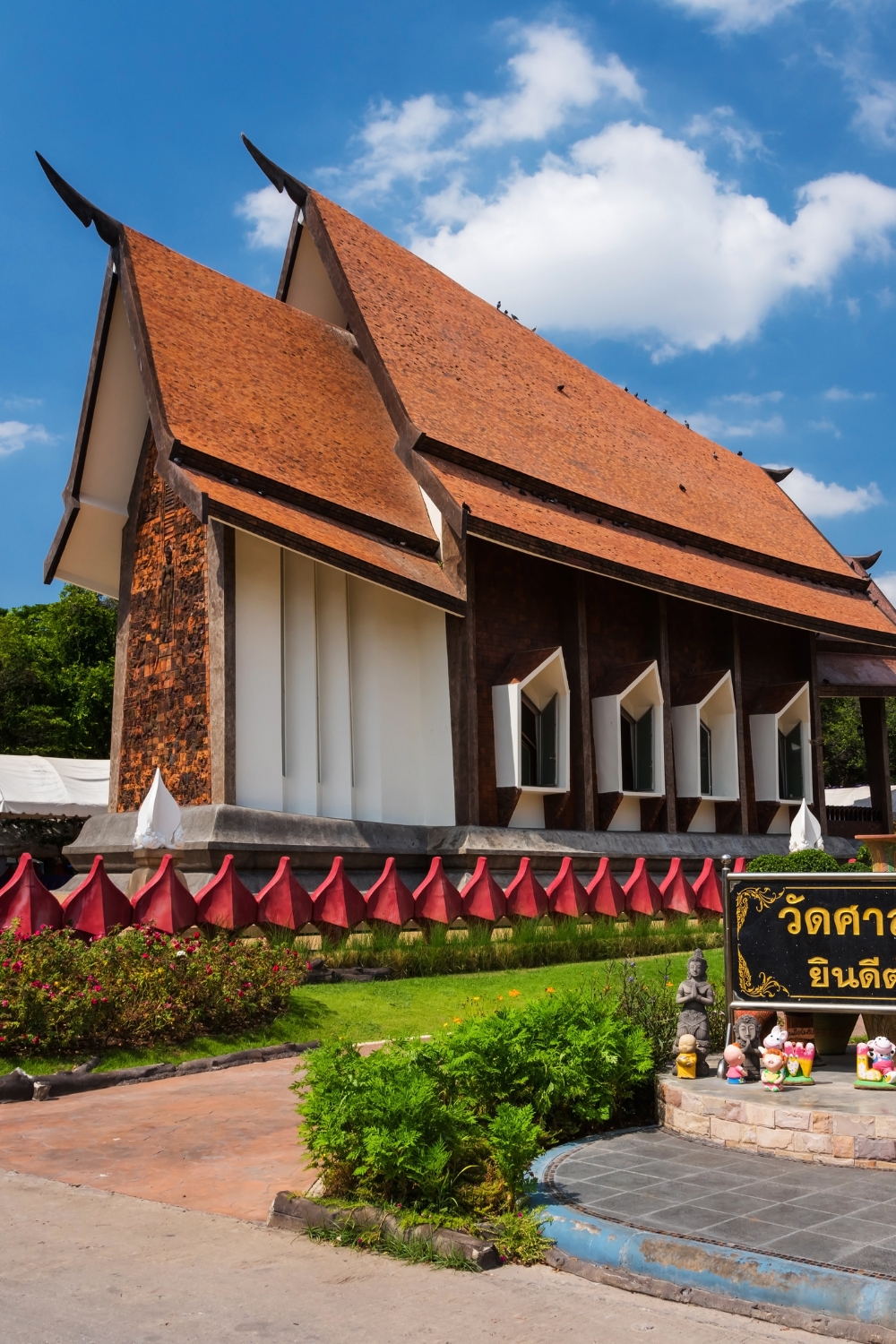
Wat Sala Loi presents a unique architectural marvel where the main temple hall appears to float on a lotus pond. This modern temple combines traditional Buddhist design with innovative engineering to create a stunning visual effect.
Innovative Architecture and Spiritual Significance
The temple’s main hall, or ubosot, sits on a foundation surrounded by water, creating the illusion of floating on the pond’s surface. This design symbolizes the lotus flower rising from muddy water to bloom in purity, representing the Buddhist path to enlightenment.
Beautiful murals inside the temple depict Buddhist teachings and local legends in vibrant colors and intricate detail. The artwork combines traditional Isan artistic styles with contemporary techniques to create visually striking religious art.
The temple grounds include meditation areas, gardens, and educational facilities that serve the local Buddhist community. Visitors can participate in morning chanting sessions, meditation practices, and dharma talks led by resident monks.
Architectural style: Contemporary Buddhist with traditional elements
Best photography time: Early morning or late afternoon
Spiritual activities: Meditation sessions, merit-making ceremonies
8. Prasat Hin Phimai – Khmer Temple Complex
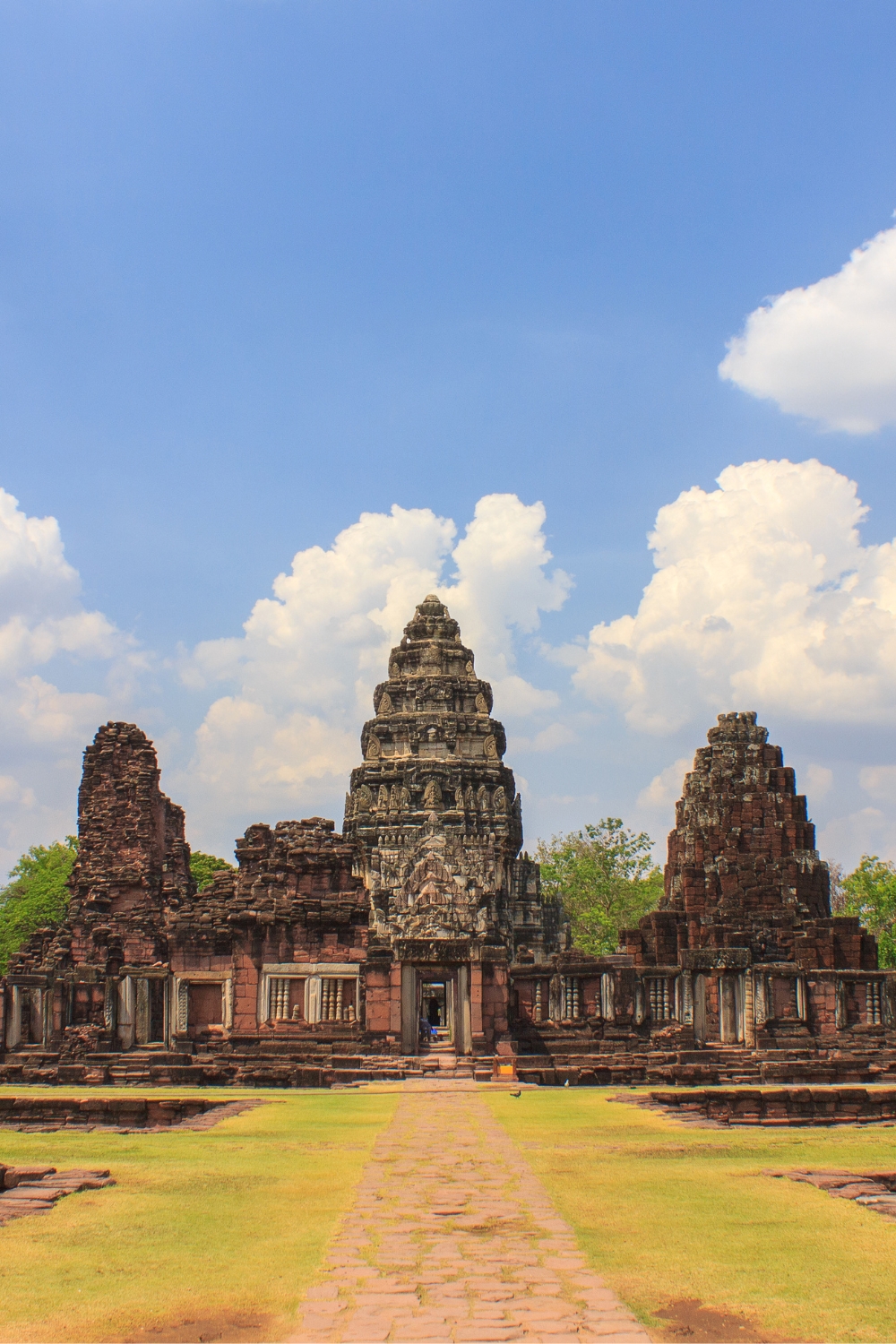
Prasat Hin Phimai stands as one of Thailand’s most important Khmer monuments, representing the northernmost major temple of the Angkor period. This architectural masterpiece showcases the sophisticated artistic and engineering achievements of ancient Khmer civilization.
Religious Evolution and Artistic Achievement
Originally built as a Hindu temple dedicated to Shiva, Prasat Hin Phimai later transformed into a Mahayana Buddhist temple, reflecting the religious changes within the Khmer Empire. Stone carvings demonstrate this evolution through Hindu and Buddhist iconography.
The temple’s layout follows classical Khmer design principles with a central tower surrounded by smaller structures, all enclosed within rectangular walls. The precise orientation and proportions reflect ancient architectural knowledge and religious symbolism.
Restoration work has revealed the temple’s original grandeur while preserving authentic architectural elements. The site demonstrates advanced construction techniques including corbel arch vaulting and intricate stone joinery without mortar.
Construction period: 11th-12th centuries CE
Religious significance: Hindu-Buddhist transition period
Architectural features: Central prang, gallery, gopura entrance
9. Khao Yai Art Museum – Contemporary Culture
Khao Yai Art Museum showcases contemporary Thai art within a beautiful setting surrounded by nature. This cultural institution provides a platform for emerging and established artists while offering visitors insight into modern Thai artistic expression.
Contemporary Art and Cultural Programs
The museum’s permanent collection includes paintings, sculptures, and mixed media works by prominent Thai artists. Rotating exhibitions feature contemporary themes, experimental techniques, and cross-cultural artistic collaborations.
Educational programs include art workshops, lectures, and cultural events that engage visitors with Thai contemporary art. The museum’s mission extends beyond display to actively promote artistic education and cultural understanding.
The museum building itself represents modern architectural design that complements the natural surroundings. Large windows provide natural lighting for artwork while offering views of the surrounding landscape.
Exhibition focus: Contemporary Thai and international art
Programs: Workshops, lectures, artist talks
Architecture: Modern design integrated with natural setting
10. Lam Takhong Dam – Scenic Recreation Area
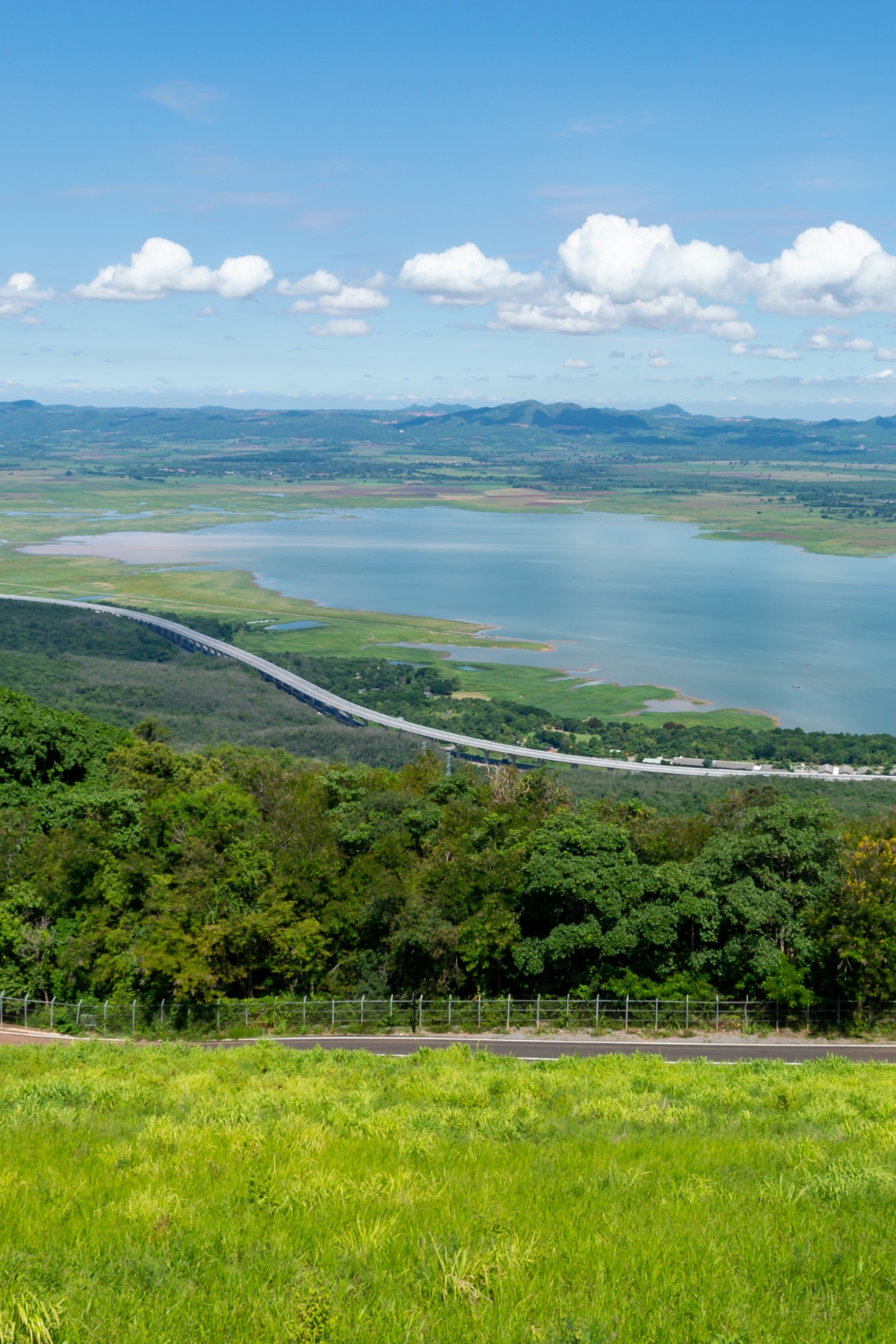
Lam Takhong Dam creates a large reservoir surrounded by forested hills, providing opportunities for water sports, fishing, and scenic relaxation. This popular recreational area offers a peaceful escape from urban environments while supporting local communities.
Water Activities and Natural Beauty
The reservoir spans over 28 square kilometers and provides water sports including boating, water skiing, and fishing. Several resorts around the lake offer equipment rental and guided activities for visitors of all skill levels.
Fishing enthusiasts can try for various freshwater species including snakehead fish, catfish, and tilapia. Local guides provide equipment and expertise for both beginners and experienced anglers seeking productive fishing spots.
The surrounding hills offer hiking trails with panoramic views of the reservoir and distant mountains. Wildlife viewing opportunities include various bird species, monkeys, and occasionally larger mammals coming to drink at the water’s edge.
Water activities: Boating, fishing, swimming
Accommodation: Lakeside resorts, camping areas
Best time: Cool season (November-February) for comfortable weather
Planning Your Korat Adventure
Getting to Nakhon Ratchasima
Nakhon Ratchasima is easily accessible from Bangkok by train, bus, or private vehicle. The train journey from Bangkok’s Hua Lamphong Station takes approximately 4-5 hours and offers scenic countryside views. Regular bus services from Bangkok’s Mo Chit Bus Terminal provide faster travel times of about 3-4 hours.
Best Time to Visit
The ideal time to visit Korat is during the cool dry season from November to February when temperatures are comfortable and rainfall is minimal. March to May can be extremely hot, while June to October brings heavy rains that may affect outdoor activities but create lush green landscapes.
Accommodation Options
Korat city offers accommodation ranging from budget guesthouses to luxury hotels. The Pak Chong area near Khao Yai provides resort-style accommodations with spa services and recreational facilities. For nature lovers, camping and bungalows within national parks offer immersive experiences.
Local Transportation
Renting a car provides the most flexibility for exploring multiple attractions, especially in the Khao Yai area. Local songthaews and tuk-tuks serve city transportation needs, while organized tours offer convenient access to major attractions with expert guides.
Essential Travel Tips
Cultural Respect and Local Customs
When visiting temples, dress modestly covering shoulders and knees, and remove shoes before entering sacred buildings. Isan culture values politeness and respect for elders, so greet locals with a wai (traditional greeting) and speak softly in religious areas.
Natural Area Guidelines
National parks require entrance fees and have specific regulations about camping, fires, and wildlife interaction. Stay on designated trails, don’t feed wild animals, and carry out all trash to preserve these pristine environments for future generations.
Food and Dining
Isan cuisine features distinctive flavors including som tam (papaya salad), larb (meat salad), and sticky rice. Local restaurants and markets offer authentic experiences, but be prepared for spicy food and unique ingredients like fermented fish sauce.
Safety Considerations
Wildlife encounters in national parks require maintaining safe distances and following guide instructions. Swimming in natural water bodies should be done cautiously, and proper hiking equipment is essential for forest trails.
Conclusion
Nakhon Ratchasima offers a remarkable journey through Thailand’s natural beauty, ancient history, and vibrant culture. From the wildlife-rich forests of Khao Yai to the ancient stones of Phimai, this province provides experiences that showcase Thailand’s incredible diversity beyond typical tourist destinations.
The region’s unique position as the gateway to Isan culture allows visitors to experience authentic northeastern Thai traditions, from traditional pottery making to local festivals celebrating historical heroes. Meanwhile, natural attractions like national parks and scenic reservoirs offer opportunities for adventure and relaxation in pristine environments.
Whether you’re seeking wildlife encounters, historical exploration, or cultural immersion, Korat delivers authentic experiences that create lasting memories. The province’s accessibility from Bangkok makes it perfect for extended stays, while its diverse attractions ensure that multiple visits reveal new discoveries and deeper cultural understanding.
Plan your Nakhon Ratchasima adventure with openness to new experiences, respect for local customs, and appreciation for both natural beauty and cultural heritage. This remarkable province will provide insights into Thailand’s rich history while creating unforgettable memories of its present-day charm and hospitality.
